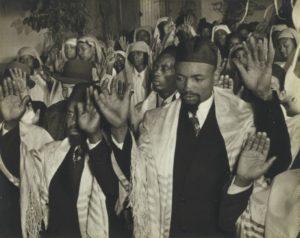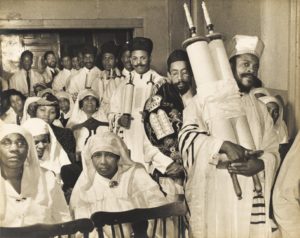Black Jew

Alexander Alland, Ethiopian Hebrews Series, №27, c. 1940. Gelatin silver print. Sheet: 8 × 10 in. (20.3 × 25.4 cm) Image: 7 3/4 × 9 3/4 in. (19.7 × 24.8 cm). Jewish Museum, New York. Purchase: Gift of Judith and Jack Stern. 1994–602

Alexander Alland, Ethiopian Hebrews Series, №14, c. 1940. Gelatin silver print, 8 × 10 in. (20.3 × 25.4 cm). Jewish Museum, New York. Purchase: Gift of Judith and Jack Stern. 1994–60
Judaism which is still known to be a primarily White race religion changed in the 1920’s.Christianity was originally forced upon the slaves and known to be the religion most African Americans practiced. However post slavery , the intermingling of blacks and Jews increased. In fact Sammy Davis Jr was one of the first celebriteies born in the 1920’s and became a Black Jew. One wouldnt think much of a person converting but an African American choosing to not be Catholic or Christain was somewhat a big deal. In fact, it was seen as “abnormal” and became the unkown. Many African Americans did not come out about being Jewish and often hid their religious practices.
In the article, “Second Glances: Two African-American Women Take a Closer Look at Their Jewish Identities”, the readers are introduced to these two ladies Amy Andre and Nzinga Kone-Miller who share their experiences growing up in the 1920’s and converting to Judasism after growing up with no religion or growing up in a strict Catholic home. Andre shares that she was the only African American she had known until college. Andre actually began to doubt the first Black Jews she met as a result of the scarcity for American Americans association with the religion. When Andre would meet White Jews howver , she was often asked, “ Are you raelly Jewsih, you dont look it”(Amy Andre and Kone- Miller Nzinga 55). This question brings up the obvious, what is a Jewish person supposed to look like? Is it only restricted to a White male with a big beard, a long top hat and curls for sideburns? This was a common stereotype for Jewish people.
African Americans converting to Judaism became a way to practice “twoness” as Stephanie Ambroise in “ Conversion: A Black Jewish Can-Do Story” explains. Oneness being togetherness, twoness exploring the division it created as other African Americans judged their fellow African American because of this difference in religion. Ambroise was also a person of color who converted and fell in love with the religion unbeknownst to ever seeing any African American. Ambroise hesitated to join the unknown as she states, “Better yet did anyone who wasn’t Caucasian practice Judaism?! I hadn’t met any or ever even heard them spoken about! Well the quickest way to find answers is to research and I did. There were Internet searches, book excerpts and many a documentary/online video watched. And oh my goodness, I found that there are Jewish people of color and in abundance who are happily observant, attending shul and planning Shabbat weekly” (Ambroise 2).
Blacks converting to Judaism was also looked at as a search for unqieuesn or indepence. Black Jews began to be separated from both African Americans and Jewish people. Hence the use of the word I previously used of “twoness”. Black Jews were outcasts to society. Quite often the norm was to be Christian because as a slave you were forced into to it, so an African Amrrian would convert to Islam or Judaism as a way of taking their choice of religion into their own hanfds. Black Jews were then looked at as people who were unsure by society. People found their choice to convert as confusion in a way, as if they were joining unkown forces in a search to find themselves. Tudor Parfitt in “Black Jews in Africa and the Americas” explains how black Jews have actually developed a strong sense of who they are as a unique people despite what people think. In Parfitt’s novel he describes how Black Jews endured, “forces of prejudice and the desire for new racial, redemptive identities converge, illuminating Jewish and black history alike in novel and unexplored ways”(Parfitt 11). It was as if searching for identiy was looked down upon by society especially if it dealt with race or religion. This is seen with Clare Kendry and Gertrude who are both manilupating race to confirm to society but are ignorant and oblioious to Claude Jones’s choice in converting to Juadaism as a means of search for his true identity.
Images from the Jewish Musuem
Sources:
Ambroise, Stephanie. “Conversion: A Black Jewish Can-Do Story.” My Jewish Learning, My Jewish Learning, 19 June 2017, www.myjewishlearning.com/jewish-and/conversion-a-black-jewish-can-do-story/.
André, Amy, and Nzinga Koné-Miller. “Second Glances: Two African-American Women Take a Closer Look at Their Jewish Identities.” Bridges, vol. 13, no. 2, 2008, pp. 52–63. JSTOR, JSTOR, www.jstor.org/stable/40358803.
Parfitt, Tudor. Black Jews in Africa and the Americas. Harvard University Press, 2013.


